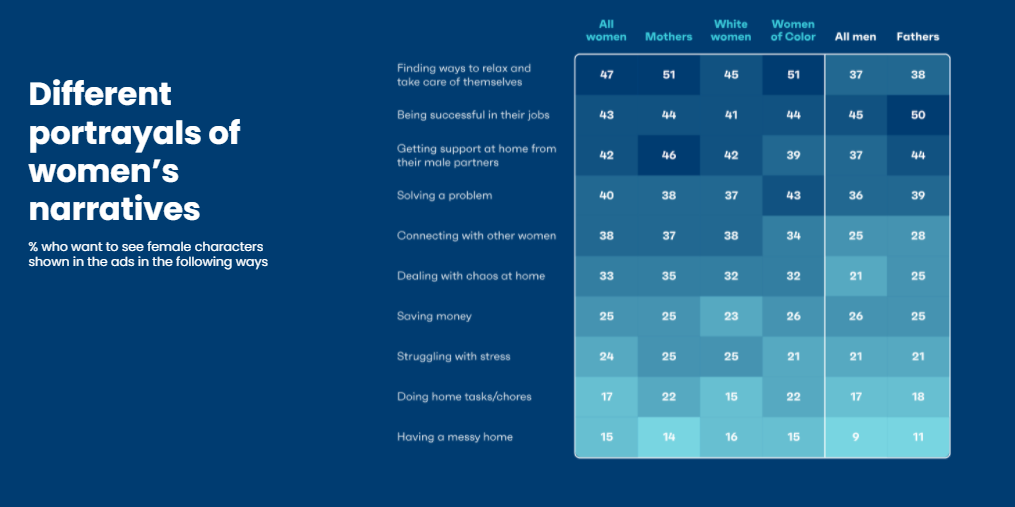The pandemic took a disproportionate toll on women, but we’ve got the stats – and the solutions – to build fresh brand-led conversations that will work.
By Annelise McCarthy, Head of Customer Success and Mid Market Account Management, North America, GWI
The pandemic was (okay, still is) hard for everyone. But it was particularly bad if you were the one who was expected to put meals on the table, do the dishes, read bedtime stories – and show up for your full-time job with a freshly laundered Zoom-suitable shirt. Adding to that, 76 percent of mothers are also on the hook for the weekly household grocery trip. It’s really not a surprise that women were 50 percent more likely than men to tell us: “My mental health declined last year.”
While fathers do share the load these days, (more insights on that in a moment) they’re not the group bearing the brunt of the household work and suffering with the mental repercussions. How do we know? We asked. Thanks to the recent research on gender inequality post-COVID [The Fragile (Im)balance: Supporting Women Post-Pandemic, conducted in partnership with SeeHer (Association of National Advertisers) we found it was moms with jobs that struggled the most.
If you want to re-engage with consumers, you’re going to need a new game plan.
Change the Conversation
Firstly, women want to be given permission to RELAX. Completely. Chill. Out. They want brands to acknowledge that they are exhausted and deserve a break. Any campaigns showing women relaxing, engaging in self-care, looking after themselves (so they are then ready to look after everyone else again) resonated very strongly with almost fifty percent of women we spoke to.
Secondly, women are tired of being misrepresented. They want to be seen as successful professionally, not just validated for their roles inside the home. For example, sitting at the head of the (boardroom) table with a rapt group of executives actually listening to their every word. Or, enjoying the view from their office-with-a-great-view (chocolate bar optional). You know, winning at life.
Now this is interesting – we heard from men that they want this too, particularly #GirlDads. Fathers know that they have a huge influence over how daughters feel about themselves. Check out Dwayne (The Rock) Johnson modeling confident “I am an awesome girl and can do anything” statements for 3-year-old Tiana. 50 percent of men with children told us they respond well to portrayals of “women succeeding in their jobs” and 39 percent liked to see problem-solving females in marketing messaging. Today’s cool dads look to the media to help build strong girls and be supportive. They know marketers wield enormous power, and they want us to use it for good.
Dream Big
Women told us they want to see an accurate reflection of their lived reality in ads. This means supporting them, encouraging them, and helping them move towards their hopes and dreams. A trend is emerging – today’s consumers want to align with brands that share their values – in good times, and bad. If brands want consumers to part with their money, they’re going to need to show up, big time.
Which brings us back to the pandemic. This has been a time of not just global, but personal, crisis and people told us they expect brands to show support. Why? Because they want to support the brands that support them. Half of those surveyed said that when a brand indicated: “We’ve got your back in tough times like these,” it impacted their purchasing decisions. Two out of three people also said that the media especially shapes how women see themselves in times of crisis. Consumers are looking for solutions. They really appreciate it when brands model good behavior and suggest coping strategies that work.
If You Can See Her, You Can Be Her
Our partner SeeHer uses their GEM ™ score as a terrific mechanism to both reward brands – and (gently) call out those who are still operating under less-than-helpful unconscious bias methodology. Brands need to reflect today’s women, in all their glorious diversities of skin tones, body shapes, gender expressions, roles, responsibilities and high five successes. Only then will consumers feel seen, heard and supported.
It’s good business. SeeHer has found that brands which triumph on the GEM ™ scorecard achieve double digit increases in purchase intent and revenue. Yes, you read that right. Authenticity drives sales. So take a look at who your consumers really are today, and take time to get to know what makes her tick.
Want some inspiration? Take a virtual tea break – because this ad from Lipton hits all the right notes with today’s female consumer. It’s authentic, fun, caring, and acknowledges her multiple roles (plus how she’s killing it on all fronts). She looks in control, but not overwhelmed, and the brand inserts itself at the perfect inflection point, showing she deserves some well-earned me time.
Okay – did you spot the twist at the end?
Hint: inside that final scene (with super clear product placement – but done really well), take a closer look at the caring guy (nice gender role switch alert). He calls her over and offers a refreshingly chilled Lipton green tea. A glass from a great table-top arrangement that he might well have set out himself. This stuff is subtle – but works.
What’s not to love? These are the sorts of messages that resonate with consumers today. See her, hear her, support her – and she’ll return the favor, building loyalty and driving revenues.







